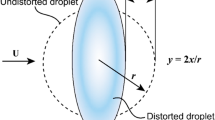Abstract
In order to ensure the best dust removal on the basis of the optimal gas emission, and to determine the best dust and gas exhaust air volume, numerical simulation research was carried out on the airflow-dust-gas field of the fully mechanized driving face. The results indicate that under different air volumes, with an increase in the distance from the head-on, the airflow velocity of the fully mechanized driving face first increased and then decreased, and gradually tended to be stable. When Q = 800–900 m3/min, the head-on gas dilution ability is strong and the range of high gas content was the minimum. When Q > 900 m3/min, the gas dilution efficiency was reduced and easy to cause secondary dust. In the height of the respiratory zone, the relationship between the dust concentration distribution and air volume is \(y=803+0.017x-2.06{x}^{2}\), and that between the gas content and air volume is \(y=0.92+\frac{173.9}{0.34\sqrt{2\pi }x}{e}^{\frac{-{[\mathrm{ln}\frac{x}{500}]}^{2}}{0.23}}\). Finally, the optimal air volume range was determined to be Q = 800–900 m3/min. By comparing the measured and simulated airflow velocity, dust concentration, and gas content, the average errors were 6.77%, 6.83%, and 7.73%, respectively, which proves the reliability of the numerical simulation results.

















Similar content being viewed by others
Data availability
Not applicable.
References
Chen JS, Jiang ZA, Tan C (2015) Numerical simulation of dust removal and ventilation system in the rock comprehensive tunneling face. J Harbin Inst Technol 47:98–103
Ding JF, Zhou G, Liu D, Jiang WJ, Wei ZY, Dong XS (2020) Synthesis and performance of a novel high-efficiency coal dust suppressant based on self-healing gel. Environ Sci Technol 54:7992–8000
Gao JL, Liu JX (2011) Probing the regularity of the gas distribution in a sloping head-face on the background of forced auxiliary ventilation. J Saf Environ 11:199–201
Han WB, Zhou G, Gao DH, Zhang ZX, Wei ZY, Wang HT, Yang HQ (2020) Experimental analysis of the pore structure and fractal characteristics of different metamorphic coal based on mercury intrusion-nitrogen adsorption porosimetry. Powder Technol 362:386–398
Han WB, Zhou G, Zhang QT, Pan HW, Liu D (2020) Experimental study on modification of physicochemical characteristics of acidified coal by surfactants and ionic liquids. Fuel 266:6966
Hasheminasab F, Bagherpour R, Aminossadati SM (2019) Numerical simulation of methane distribution in development zones of underground coal mines equipped with auxiliary ventilation. Tunn Undergr Space Technol 89:68–77
Hu SY, Feng GR, Ren XY, Xu G, Chang P, Wang Z, Zhang YT, Li Z, Gao Q (2016) Numerical study of gas-solid two-phase flow in a coal roadway after blasting. Adv Powder Technol 27:1607–1617
Hu S, Liao Q, Feng G, Huang Y, Shao H, Fan Y, Ye Y (2019) Numerical study of gas-solid two-phase flow around road-header drivers in a fully mechanized excavation face. Powder Technol 344:959–969
Hua Y, Nie W, Liu Q, Peng HT, Wei WL, Cai P (2020) The development and application of a novel multi-radial-vortex-based ventilation system for dust removal in a fully mechanized tunnelling face. Tunn Undergr Space Technol 98:103253
Kong B, Wang E, Li Z (2018) The effect of high temperature environment on rock properties-an example of electromagnetic radiation characterization. Environ Sci Pollut Res 25:29104–29114
Kurnia JC, Sasmito AP, Mujumdar AS (2014) CFD simulation of methane dispersion and innovative methane management in underground mining faces. Appl Math Model 38:3467–3484
Li SL, Zhou G, Liu ZQ, Wang NG, Wei ZY, Liu W (2020) Synthesis and performance characteristics of a new ecofriendly crust-dust suppressant extracted from waste paper for surface mines. J Clean Prod 258:120620
Liu K, Deng JQ, Ye FH (2019) Numerical simulation of flow structures in a rotary type energy recovery device. Desalination 449:101–110
Liu RL, Ji DX, Zhou G, Liu ZQ, Xu QF, Seera R (2020) Electrospun nanofibers for personal protection in mines. Chem Eng J 404:126558
Liu RL, Zhou G, Wang CM, Jiang WJ, Wei X (2020) Preparation and performance characteristics of an environmentally-friendly agglomerant to improve the dry dust removal effect for filter material. J Hazard Mater 397:122734
Ma YL, Zhou G, Ding JF, Li SL, Wang G (2018) Preparation and characterization of an agglomeration-cementing agent for dust suppression in open pit coal mining. Cellulose 25:4011–4029
Ni GH, Dong K, Li S, Sun Q (2019) Gas desorption characteristics effected by the pulsating hydraulic fracturing in coal. Fuel 236:190–200
Song SZ, Zhou G, Duan JJ, Zhang LC, Gao DH, Sun B (2020) Numerical simulation investigation on optimal dust-exhausting airflow volume in fully mechanized caving face of high-gas coal mine. Process Saf Environ Prot 146:853–866
Sun B, Cheng WM, Wang JY, Wang H, Ma YY (2019) Development of Venturi negative-pressure secondary dedust device and application of local spray closure technique. Adv Powder Technol 30:42–54
Sun J, Zhou G, Wang CM, Liu RL, Miao YA (2021) Experimental synthesis and performance comparison analysis of high-efficiency wetting enhancers for coal seam water injection - ScienceDirect. Process Saf Environ Prot 147:320–333
Torano J, Torno S, Menendez M, Gent M (2011) Auxiliary ventilation in mining roadways driven with roadheaders: validated CFD modelling of dust behaviour. Tunn Undergr Space Technol 26:201–210
Wang ZW, Ren T, Cheng YP (2017) Numerical investigations of methane flow characteristics on a longwall face Part I: methane emission and base model results. Journal of Natural Gas Science and Engineering 43:242–253
Wang ZW, Ren T, Cheng YP (2017) Numerical investigations of methane flow characteristics on a longwall face Part II: parametric studies. Journal of Natural Gas Science and Engineering 43:254–267
Wang JY, Zhou G, Wei X, Wang SC (2019) Experimental characterization of multi-nozzle atomization interference for dust reduction between hydraulic supports at a fully mechanized coal mining face. Environ Sci Pollut Res 26:10023–10036
Wang YP, Jiang ZA, Wang JZ, Zheng DF, Chen JH, Yang B, Wang M (2020) The visualization study of dust pollution generated during unloading of the multi-level in high ore pass based on CPFD software and similar experiments. J Clean Prod 26:120371
Wu MY, Hu XM, Zhang Q, Xue D, Zhao YY (2019) Growth environment optimization for inducing bacterial mineralization and its application in concrete healing. Constr Build Mater 209:631–643
Yin WJ, Zhou G, Gao DH (2019) Simulation analysis and engineering application of distribution characteristics about multi-stage atomization field for cutting dust in fully mechanized mining face. Adv Powder Technol 30:2600–2615
Yu HM, Cheng WM, Peng HT, Xie Y (2018) An investigation of the nozzle’s atomization dust suppression rules in a fully-mechanized excavation face based on the airflow-droplet-dust three-phase coupling model. Adv Powder Technol 29:941–956
Zhang GB, Zhou G, Song SZ, Zhang LC, Sun B (2020a) CFD investigation on dust dispersion pollution of down/upwind coal cutting and relevant countermeasures for spraying dustfall in fully mechanized mining face. Adv Powder Technol 31:3177–3190
Zhang GB, Zhou G, Zhang LC, Sun B, Wang NG, Yang HQ, Liu W (2020b) Numerical simulation and engineering application of multistage atomization dustfall at a fully mechanized excavation face. Tunn Undergr Space Technol 104:103540
Zhou G, Zhang Q, Bai R, Fan T, Wang G (2017) The diffusion behavior law of respirable dust at fully mechanized caving face in coal mine: CFD numerical simulation and engineering application. Process Saf Environ Prot 106:117–128
Zhou G, Ding JF, Ma YL, Li SL, Zhang M (2020) Synthesis and performance characterization of a novel wetting cementing agent for dust control during conveyor transport in coal mines. Powder Technol 360:165–176
Zhou G, Zhang QT, Hu YY, Gao DH, Wang SC, Sun B (2020) Dust removal effect of negatively-pressured spraying collector for advancing support in fully mechanized coal mining face: numerical simulation and engineering application. Tunn Undergr Space Technol 95:103149
Zhou G, Duan JJ, Sun B, Jing B, Kong Y, Zhang YL, Ni GH, Sun LL (2022) Numerical analysis on pollution law for dust and diesel exhaust particles in multi-ventilation parameter environment of mechanized excavation face. Process Saf Environ Prot 157:320–333
Funding
This work was financially supported by the National Natural Science Foundation of China (Grant nos. 52274215, 51904171, 52004150), the Qingchuang Science and Technology Project of Universities in Shandong Province, China (Grant no. 2019KJH005), and the Outstanding Young Talents Project of Shandong University of Science and Technology (Grant no. SKR22-5-01).
Author information
Authors and Affiliations
Contributions
All authors contributed to the study conception and design. Gang Zhou: supervision, project administration, funding acquisition. Yating Hu: conceptualization, writing—original draft, writing—review and editing. Ruixin Song: investigation, formal analysis. Biao Sun: data curation. Yongwei Liu, Yang Yang: methodology.
Corresponding author
Ethics declarations
Ethics approval and consent to participate
All analyses are based on previously published research. The research does not involve ethical and moral issues, so no moral approval is required.
Consent for publication
We would like to submit the enclosed manuscript entitled “Numerical simulation investigation on optimal air volume for dilution dust-gas by forced ventilation in fully mechanized driving face,” which we wish to be considered for publication in “Environmental science and pollution research.” I would like to declare on behalf of my co-authors that the work described was original research that has not been published previously, and not under consideration for publication elsewhere, in whole or in part.
Competing interests
We declare that we have no financial and personal relationships with other people or organizations that can inappropriately influence our work, there is no professional or other personal interest of any nature or kind in any product, service and/or company that could be construed as influencing the position presented in, or the review of, the manuscript entitled, “Numerical simulation investigation on optimal air volume for dilution dust-gas by forced ventilation in fully mechanized driving face.”
Additional information
Communicated by Marcus Schulz.
Publisher's Note
Springer Nature remains neutral with regard to jurisdictional claims in published maps and institutional affiliations.
Rights and permissions
Springer Nature or its licensor holds exclusive rights to this article under a publishing agreement with the author(s) or other rightsholder(s); author self-archiving of the accepted manuscript version of this article is solely governed by the terms of such publishing agreement and applicable law.
About this article
Cite this article
Zhou, G., Hu, Y., Song, R. et al. Numerical simulation investigation on optimal air volume for dilution dust-gas by forced ventilation in fully mechanized driving face. Environ Sci Pollut Res 30, 17723–17740 (2023). https://doi.org/10.1007/s11356-022-23152-z
Received:
Accepted:
Published:
Issue Date:
DOI: https://doi.org/10.1007/s11356-022-23152-z




